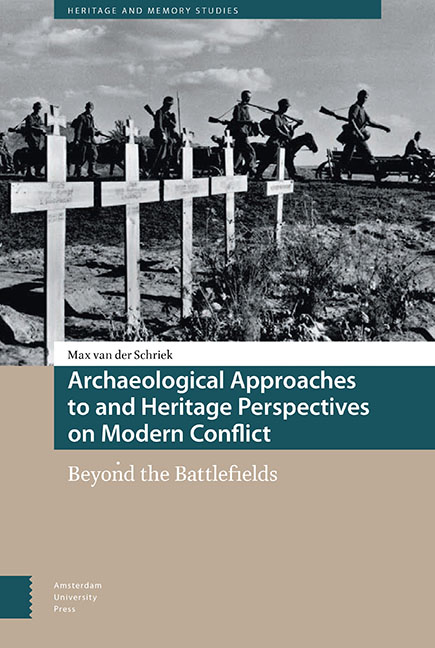Book contents
- Frontmatter
- Dedication
- Contents
- List of figures
- Acknowledgements
- 1 Introduction
- 2 Conflict archaeology
- 3 Landscape biographies of commemoration
- 4 Status quaestionis of conflict archaeology
- 5 Scientific and societal importance
- 6 The application of LiDAR-based DEMs
- 7 Summary and final debate
- Synopsis
- Appendix: WWII-related archaeological researches in the Netherlands (1984-2017)
- Bibliography
- Index
- Frontmatter
- Dedication
- Contents
- List of figures
- Acknowledgements
- 1 Introduction
- 2 Conflict archaeology
- 3 Landscape biographies of commemoration
- 4 Status quaestionis of conflict archaeology
- 5 Scientific and societal importance
- 6 The application of LiDAR-based DEMs
- 7 Summary and final debate
- Synopsis
- Appendix: WWII-related archaeological researches in the Netherlands (1984-2017)
- Bibliography
- Index
Summary
Abstract
Aims and research perspectives are explained in this introduction chapter. To start with, this study is to be viewed as fundamental research with regard to an interdisciplinary approach consisting of heritage, archaeology and spatial development perspectives. Secondly, by assessing and validating the academic value of conflict archaeology in the Netherlands, it is a valuation study. And last, by implementing a non-invasive technique on sites of modern conflict, it can be considered methodological research. Explicit research goals were the development of archaeological research questions for conflict archaeology in the Netherlands. For both the preservation and conservation of sites of modern conflict, community interest is always of the utmost importance, as demonstrated by the example of Mont Cornillet.
Keywords: conflict archaeology, heritage management, the Netherlands, Mont Cornillet
The tragedy at Mont Cornillet
Reims, France, 1917. The Battle of the Hills, better known as the Nivelle Offensive (17 April-20 May) has reached its climax. The German lines have been under attack by French forces for over a month. Most of the Germans’ first and second lines between Soissons and Reims have been captured after fierce fighting. East of the city of Reims, there are several important high points, including Mont Cornillet, with its 207-metre-high summit. After the heavy losses at Verdun and at the Battle of the Somme the year before, the German army is in desperate need of fresh troops. The Württembergisches Infanterie-Regiment Nr. 476 (Inf. Reg. Nr. 476) was formed in January 1917, consisting mostly of young, unexperienced troops. Some more experienced officers and non-commissioned officers were added from other regiments to form the backbone of Inf. Reg. Nr. 476, including Leutnant Carl Heinrich Albert Schumacher (*1891-†1980). After several short weeks of training, the regiment was sent to France in March, where it received its baptism of fire in May 1917.
On 14 May, Inf. Reg. Nr. 476 arrived at Mont Cornillet, where an important underground fortress had been built that consisted of three long, parallel tunnels dug into the limestone. The largest of these tunnels was 280 metres long, featuring entrances at both sides, and was named ‘Lux’. The tunnels, which were approximately two metres wide and two metres high, were also connected. The French High Command was aware of the existence of this underground fortress, and French troops unsuccessfully attempted to seize the summit on 17 April and again on 30 April 1917.
- Type
- Chapter
- Information
- Archaeological Approaches to and Heritage Perspectives on Modern ConflictBeyond the Battlefields, pp. 21 - 36Publisher: Amsterdam University PressPrint publication year: 2022

